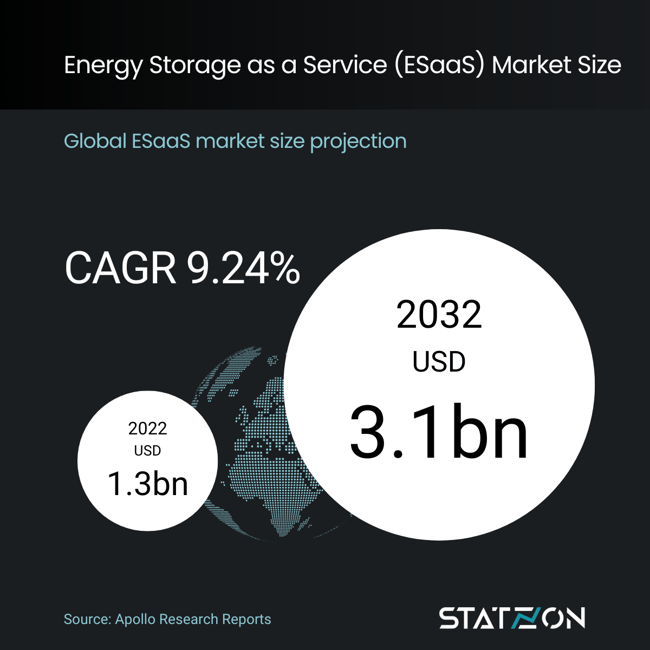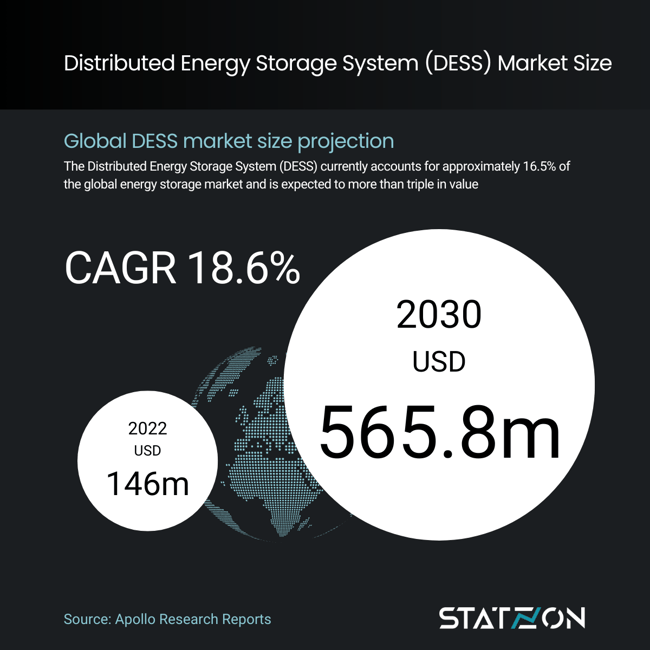Affordable energy storage stands at the crossroads of a pivotal transformation in the way we generate, distribute, and consume electricity. It's increasingly viewed as the critical missing link that could bridge the gap between the intermittent nature of renewable power sources, like solar and wind, and the dream of round-the-clock reliability. Beyond the renewables integration, utilities see vast potential in energy storage for applications ranging from easing grid congestion to smoothing out the inevitable fluctuations in power supply, regardless of the source. Meanwhile, the broader industrial sector envisions energy storage as a revolutionary force capable of transforming not just how we power our vehicles, turbines, and gadgets, but also the very fabric of our electrical infrastructure.
What is Energy Storage as a Service (ESaaS)?
At the heart of this transformation is the concept of "as a service" models, which are changing the landscape of infrastructure investment. By removing the barrier of upfront capital expenditure, these models are empowering companies across the spectrum to leap forward into high-value, technologically advanced solutions with confidence in their expected outcomes. Energy Storage as a Service (ESaaS) epitomizes this shift. ESaaS offers businesses and organizations the opportunity to deploy cutting-edge energy storage and management systems through a service agreement, rather than a direct purchase. This model not only facilitates cost savings and operational efficiencies but also enhances energy reliability and resilience, making it a viable strategy for entities looking to successfully transition towards more sustainable energy systems.
Components of Energy Storage as a Service Business Model
Energy Storage as a Service (ESaaS) integrates three key components to provide a streamlined energy management solution:
- Energy Storage System (ESS): Central to ESaaS is the ESS, which typically employs advanced battery technologies, such as lithium-ion or flow batteries, chosen for their efficiency and rapid response to energy demands. These batteries are selected to match the facility's specific energy needs and can be complemented by alternative storage technologies, like compressed air or flywheels, based on the facility's unique requirements. The ESS is equipped with a power conversion system to ensure compatibility with the facility’s electrical infrastructure.
- Control and Monitoring System: ESaaS systems are managed through a Supervisory Control and Data Acquisition (SCADA) system. This system continuously liaises with the facility's Energy Management System (EMS), as well as the power conversion and battery management systems, to optimize energy flow and maintain the health of the batteries. It allows for remote supervision by the ESaaS provider, offering real-time responses to energy requirements and enabling participation in energy-saving programs for cost efficiency.
- Service Contract: The commercial relationship is formalized through a service contract, which defines the terms of service, the payment structure, and the specific services offered. This contract ensures that the ESaaS provider manages the complex operations of the energy storage system, allowing the client to benefit from the technology with minimal operational burden.
Energy as a Service (ESaaS) Market Value and Growth
Bloomberg's prediction on the energy storage market suggests that anticipated overproduction and excess capacity will drive down the prices of lithium-ion battery packs and energy storage systems. This price reduction, as manufacturers seek to mitigate losses from underutilized investments, is likely to boost the broader adoption of energy storage solutions.
However, the development of these systems faces significant challenges, particularly the high capital costs associated with their substantial size and weight. A study by NREL indicates that the capital cost for a complete 4-hour lithium-ion battery system ranges between USD 347 to USD 500 in 2023. Despite the trend of decreasing prices, manufacturers encounter added pressure from requirements to localize manufacturing, potentially elevating production costs, especially when shipping large, predominantly empty steel casings across borders.
The advent of Storage as a Service (SaaS) models is emerging as a solution, enabling businesses to leverage energy storage benefits without the burden of upfront expenses. The ESaaS financial model permits manufacturers to maintain ownership and oversight of their batteries throughout their lifecycle, ensuring they meet environmental responsibilities while still capitalizing on residual revenues. ESaaS offers the adaptability to align with market changes, thus reducing the financial risks tied to energy storage infrastructure.
Consequently, the global ESaaS market is on an upward trajectory, projected to grow from USD 1.3 billion in 2022 to USD 3.1 billion by 2032, achieving a CAGR of 9.24% from 2023 to 2032.
ESaaS Market Share by Type of Service
The Energy Storage as a Service (ESaaS) market is diversifying across various service types, each contributing differently to the sector's growth. According to Apollo Research Reports, the market is differentiated into 6 segments that include Bulk Energy Services, Ancillary Services, Transmission Infrastructure Services, Distribution Infrastructure Services, Customer Energy Management Services, and Other Services, with a total valuation of USD 1.299 billion.
Customer Energy Management Services emerged as the largest segment, valued at USD 434.2 million in 2022. This segment is expected to nearly double, reaching USD 981.9 million by 2032, with a CAGR of 8.58%.
Ancillary Services, essential for maintaining grid stability and reliability, started at USD 328.9 million, expected to rise to USD 716.5 million, growing at a CAGR of 8.17%.
Transmission Infrastructure Services accounted for USD 136.5 million, set to increase to USD 398.2 million by 2032, with a CAGR of 11.36%. These services enhance the efficiency and reliability of the transmission grid.
The Distribution Infrastructure Services segment is forecasted to grow at the highest CAGR of 13.55%, reaching USD 243.7 million.
Customer Energy Management Services, which assist customers in optimizing their energy use and costs, were the largest segment at USD 434.2 million. This sector is expected to nearly double, reaching USD 981.9 million by 2032, with a CAGR of 8.58%.
Other Services, encompassing various smaller segments of the ESaaS market, were valued at USD 167.4 million and are projected to grow to USD 292.3 million at a CAGR of 5.75%.
The Market for Distributed Energy Storage System (DESS)
As the energy sector is witnessing the transition of power generation from large, centralized facilities to localized, renewable sources such as solar and wind power, the role of Distributed Energy Storage Systems (DESS) is becoming increasingly critical, especially as distributed renewables such as solar photovoltaic (PV) systems experience rapid growth.
In 2022, distributed PV systems, which include small-scale solar installations for various applications, accounted for 48% of global solar PV capacity additions, marking the highest annual growth in history. This trend is projected to continue, with the International Energy Agency (IEA) forecasting that distributed PV capacity will surge to 140 gigawatts by 2024, a more than 30% increase from 2022 levels.
In this transition to DER, Energy Storage as a Service (ESaaS) emerges as a game-changing business model. ESaaS simplifies the financial and operational complexities of integrating and managing DESS projects, facilitating the broader integration of energy storage into the electrical grid. This model not only makes energy storage investments more attractive but also essential for the future energy landscape, enhancing the integration of renewable energy sources.
Central to the ESaaS model are DESS projects, crucial for targeted energy load reduction without compromising operational efficiency. By integrating Energy Savings Performance Contracts (ESPC) with DESS, ESaaS enables agreements that ensure savings on demand charges through operating lease agreements. This innovative approach allows customers to access advanced energy storage solutions without substantial upfront costs, significantly lowering the cost barrier and cementing ESaaS's role in fostering the adoption and economic viability of DERs amidst the expanding renewable energy market.
As the renewable energy market expands, so does the demand and market for DESS. Growing at a CAGR of 18.6%, DESS now represents about 16.5% of the global energy storage market. With a global market value of USD 146 million in 2022, DESS is expected to more than triple in value, reaching USD 565.8 million by 2030, according to Apollo Research Reports.
DESS and ESaaS combined make powerful combo. DESS integrates numerous small-scale energy storage units into a network, creating a decentralized and resilient energy ecosystem. ESaaS optimizes and manages these distributed storage assets efficiently, contributing to grid flexibility and supporting the integration of renewable energy sources.
Source: Statzon, Apollo Research Reports study on ESaaS, Apollo Research Reports study on Energy Storage and Battery Management System Market, Forbes, IEA, Bloomberg, NREL



